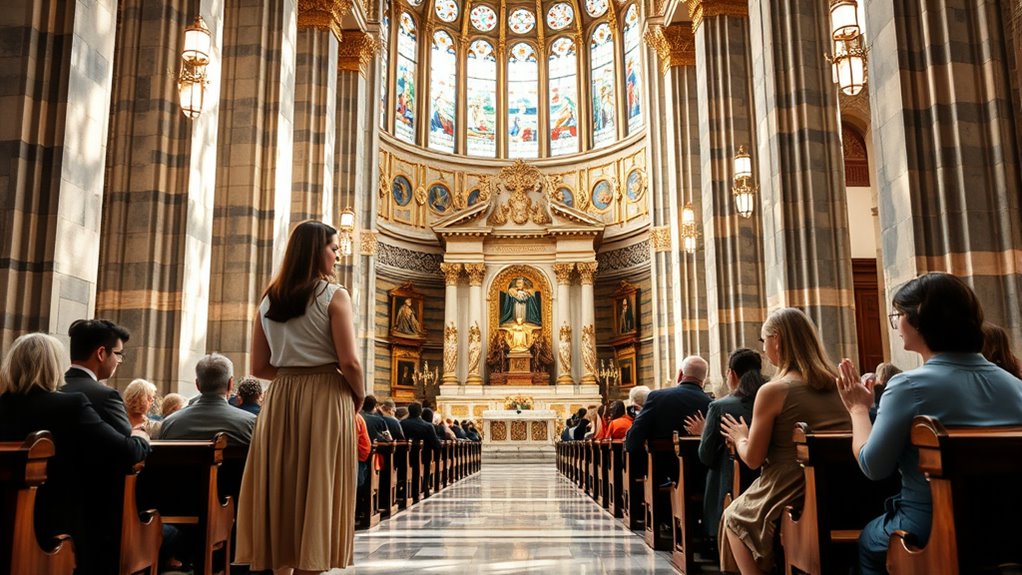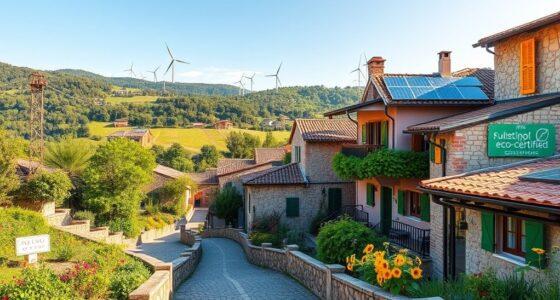When visiting Italian religious sites, dress modestly by covering shoulders and knees and avoid casual clothing like shorts or tank tops. Be respectful by speaking softly, observing rituals, and following posted rules on photography—especially inside worship areas. Show reverence through your behavior, remove hats, and minimize disruptions. Respect local customs and traditions to honor the sacred environment. If you want to understand more about cultural norms, there’s additional guidance to help you engage appropriately during your visit.
Key Takeaways
- Dress modestly by covering shoulders and knees; women can use scarves or shawls if needed.
- Follow signage and staff instructions regarding photography restrictions inside sacred areas.
- Maintain a respectful, quiet demeanor; speak softly and avoid disruptive actions during worship or ceremonies.
- Remove hats and avoid loud conversations to honor the sanctity of religious sites.
- Respect local customs and rituals, demonstrating reverence through appropriate attire and considerate behavior.

Visiting Italian religious sites offers a unique glimpse into the country’s rich spiritual heritage, but it’s important to respect local customs and traditions. When you enter these sacred spaces, your attire plays a vital role in showing reverence. Most churches, cathedrals, and basilicas have a dress code that you should adhere to. This typically means covering your shoulders and knees, so avoid tank tops, sleeveless shirts, or shorts. Women might consider bringing a scarf or shawl to cover their shoulders if necessary, and men should opt for modest clothing as well. Dressing appropriately not only shows respect but also helps you blend in with other visitors and locals who take these customs seriously. Additionally, respecting user privacy and site rules enhances your experience and maintains the sanctity of the environment.
Photography rules vary from site to site, so it’s essential to pay attention to posted signs or ask staff if you’re unsure. Many religious sites prohibit photography inside the main worship areas to preserve the sanctity and avoid disturbing worshippers. Flash photography is often forbidden because it can damage artwork and stained glass windows, so be prepared to turn off your flash or avoid taking pictures altogether in certain zones. Outside or in designated areas, photography might be allowed, but always be considerate of worshippers and pilgrims who may find camera flashes intrusive or disruptive. Additionally, some sites have restrictions on the use of tripods or selfie sticks, so check beforehand to prevent any inconvenience.
Beyond dress code and photography, your behavior should reflect the solemnity of the environment. Keep noise to a minimum, and speak softly if you need to converse. Remember that these sites serve as places of worship, reflection, and prayer, so maintain a respectful attitude at all times. If you’re participating in a service or mass, follow the lead of others and observe any specific customs or rituals. Removing hats, refraining from loud conversations, and avoiding disruptive actions are simple ways to demonstrate your respect.
Frequently Asked Questions
Are Photography and Filming Allowed Inside Religious Sites?
You should always check photography restrictions and filming guidelines before entering Italian religious sites. Generally, photography and filming are permitted, but some places may have strict rules to protect their sacred atmosphere. You might need to turn off flash, avoid using tripods, or restrict photography to certain areas. Respect these guidelines to avoid causing disturbances and to ensure you honor the site’s spiritual significance.
Is It Necessary to Wear Formal Attire or Specific Clothing?
You don’t need to wear formal attire, but dressing respectfully is essential. An appropriate dress code involves covering shoulders and knees, so opt for modest clothing like skirts, pants, or shawls. This respectful attire shows your appreciation for the sacred space and helps you blend in with local visitors. Remember, it’s about honoring the site’s significance, not about dressing to impress. Keep it simple, respectful, and comfortable.
Can I Participate in Religious Ceremonies as a Visitor?
Yes, you can participate in religious ceremonies as a visitor, but you should follow participation etiquette and respect visitor roles. Observe how locals engage and wait for appropriate moments to join in. Keep your movements respectful, dress modestly, and avoid disrupting the ceremony. If you’re unsure, ask a staff member or a local for guidance. Showing respect and understanding helps you engage meaningfully while honoring the sacred space.
Are There Any Specific Behaviors to Avoid in Sacred Areas?
You should avoid loud conversations and disruptive behavior in sacred areas, which are taken very seriously—over 80% of visitors respect silence in Italian churches. Always dress modestly, covering shoulders and knees, and speak quietly to honor the space. Refrain from taking photos where it’s prohibited or touching religious artifacts. Respect the customs, and you’ll show proper reverence, ensuring your visit remains respectful and meaningful.
What Should I Do if I Accidentally Offend Local Customs?
If you accidentally offend local customs, apologize sincerely and show your respect. It’s best to acknowledge your mistake calmly and humbly. Seek local guidance if you’re unsure about what’s appropriate; locals appreciate your effort to understand their customs. Being genuine and respectful helps smooth over any missteps, and most people will appreciate your willingness to learn. Always remember, a sincere apology goes a long way.
Conclusion
By following these customs, you become a respectful traveler, honoring Italy’s spiritual heartbeat. Just as a gentle breeze respects the quiet of a sacred garden, your mindful behavior preserves the sacred silence and serenity. Remember, each gesture is a brushstroke in the masterpiece of cultural understanding. When you walk these hallowed halls with reverence, you don’t just visit a site—you become part of its enduring story, a small but meaningful ripple in Italy’s rich spiritual pond.








